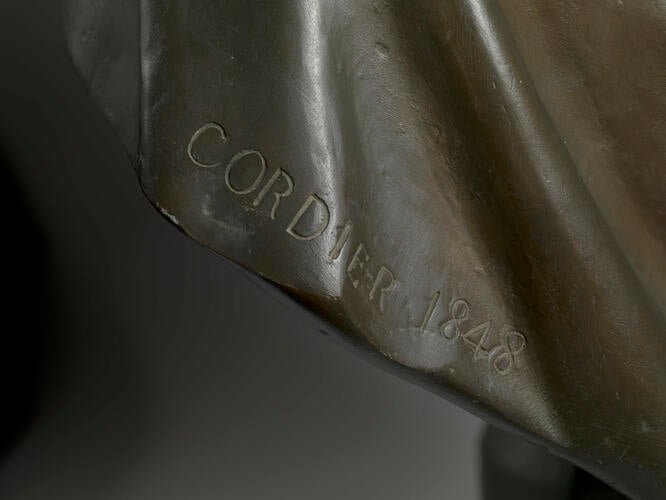-
1 of 253523 objects
Saïd Abdallah, de la Tribu de Mayac, Royaume de Darfour 1848
Bronze | 83.1 x 52.0 x 41.0 cm (excluding base/stand) | RCIN 41509

Charles Cordier (1827-1905)
Saïd Abdallah, de la Tribu de Mayac, Royaume de Darfour 1848

Charles Cordier (1827-1905)
Saïd Abdallah, de la Tribu de Mayac, Royaume de Darfour 1848

Charles Cordier (1827-1905)
Saïd Abdallah, de la Tribu de Mayac, Royaume de Darfour 1848




-
This bust was acquired by Queen Victoria in September 1852, along with its pair Vénus africaine having been sold by the sculptor, Cordier, in June to the dealer Peter Graham, partner in the leading London furnishing firm Jackson & Graham.
Images of distant peoples became increasingly familiar to Europeans from the 1840s through the spread of photography and as the result of anthropological studies made in the course of scientific expeditions. These often included the measurement of the heads of native peoples and frequently the preparation of plaster casts ‘from the life’ for the study of phrenology.
The sculptor Charles Cordier was among the first to recognise the artistic as well as the scientific potential of such subjects, and his busts of anonymous African and Far Eastern sitters challenged Western ideals of beauty. The son of a pharmacist from Cambrai in north-eastern France, he came to settle in Paris in around 1845 and entered the studio of François Rude. It was there that he encountered Saïd Enkess, a formerly enslaved Sudanese man, and decided to make his portrait (Saïd Abdallah). Enkess had been purchased in Cairo by a Mr Goria, who brought him to Italy and sold him on to the Prussian Consul in Livorno. In 1838 he came to France with Prince Galitzine. Slavery was finally abolished in France only in 1848, the year that Enkess sat to Cordier for the bust. Exhibited in plaster at the Salon of that year, Cordier's bust was instantly successful and determined the subsequent direction of his career as a sculpteur ethnographique.
By the time Cordier's Saïd Abdallah was first shown in bronze, at the Salon of 1850, it had been given a new name, Nègre de Tomboctou, at once less specific and more evocative than the 1848 title. It was included in the French section of the Great Exhibition in 1851 where it won a Prize Medal in Class 30, Division A2 (Sculpture in Metals compound). The founder, Simonet, was commended for ‘a masterly specimen of both casting and tooling’. The jury in section A1 (Sculpture on a large Scale) awarded the bust an Honourable Mention, considering it ‘a true example of characteristic portraiture; the conception is full of life, the execution is most masterly’.
According to Cordier's own account, which is probably not entirely trustworthy, both the Queen and Prince Albert inquired about purchasing the bust, as a Christmas present for the other. In fact, it seems already to have been promised to the Duke of Devonshire, employer of Joseph Paxton, the designer of the Crystal Palace, and once the patron of Canova.
At least eighteen full-size versions and numerous small reductions of the Saïd Abdallah are known, some finished with gilding, silvering and enamels. The drapery of both Royal Collection busts was described in the 1873 Osborne inventory as silvered, but there is no longer any trace of this treatment on either.
Text from Victoria & Albert: Art & Love.Provenance
Purchased by Queen Victoria (payment dated 13 September 1852, £201 5s for a pair of busts including Saïd Abdallah, (RA QV Journal 1852/121)) through Messrs Jackson & Graham;
Given to Prince Albert by Queen Victoria on his birthday 26th August 1852 [Victoria & Albert: Art & Love, London, 2010, pg 460]
-
Creator(s)
(sculptor)(retailer/supplier)Acquirer(s)
-
Medium and techniques
Bronze
Measurements
83.1 x 52.0 x 41.0 cm (excluding base/stand)